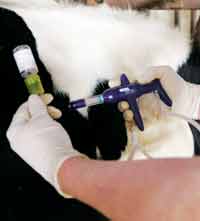Bluetongue map shows vaccine uptake

With worrying early signs suggesting bluetongue vaccination uptake may be down on last year, what strategies are farmer’s adopting in your area and why? Aly Balsom spoke to a number of vets to find out.
Look at the map for more in depth findings in specific regions.
The North
Compared to last year where vaccination in the north was slow to start, the level of uptake of Bovilis BTV8 vaccine here has been significantly higher this year, said Ian Anderson of Intervet/Schering-Plough.
In northern England, more BTV8 vaccine has gone into the east than the west of the region, which is surprising given the high stock numbers in the area, said Mr Anderson.
Alistair Mackintosh, livestock board chairman, NFU has also recognised an increase in vaccine uptake in some areas.
“A lot more farmers are fitting bluetongue vaccination into their every day farming practice.”
“I would always like to see more, but generally response is positive.”
“Why run the risk of infection?” Mr Mackintosh asked. “Vaccination is an incredibly cheap option.”
“It is still early in the year to judge vaccine uptake as many farmers did not give the first dose until September last year so there is still time for them to buy the booster.
“But if farmers are questioning vaccinating again this year, there is only one answer – don’t hesitate vaccinate,” he said.
The South
The majority of BTV8 sales this year have been in the south where farmers still perceive the risk to be greatest, said Ian Anderson of Intervet/Schering-Plough.
“In the south, uptake from the east to the west of the country has been relatively even, although the number of doses going out into the market has been less than last year as cattle only require one 1ml dose to boost the primary course.”
The South East
We must congratulate the work of farmers in the south east, said Matt Dobbs, vet for WestPoint Vets, West Sussex. “There is no doubt, their efforts to vaccinate 98.9% of stock last year helped prevent a disease outbreak.”
One such farmer is John Collen, Lowestoft, Suffolk, who has experienced first hand the distressing effects of the disease.
“The welfare implications associated with the bluetongue disease are huge. In 2007 we saw all the clinical signs associated with bluetongue alongside increased abortion rates. The only way this can be controlled is through vaccination.”
At the moment we are seeing uptakes is about 50% of what it was last year, but I would expect this to pick up in next few months as farmers start giving annual booster, said Mr Dobbs.
The South West
Uptake in the South West appears to be slightly down in some areas, with many farmers believing they are too far away from the threat for it to be a problem, said Matthew Berriman, Rosevean vet practice.
“We expect uptake to be 10% lower than last year as farmers perceive there is no risk of the disease.”
Yet, auctioneers in the South West are reporting a marked increase in livestock imports, exposing farmers to added risk.
Sheep flocks must vaccinate against bluetongue
Sheep farmers are the ones that will see the most significant effects of a bluetongue outbreak, said vet, Keith Cutler, Endell Vet Group, Wiltshire. The consequences of a bluetongue outbreak in sheep remains substantially more severe than those with cattle.
“Cattle producers may see production drops, but animals are likely to recover, however, sheep are more likely to die following infection.”
It may be understandable that producers are not vaccinating early finishers, but it is essential other stock is protected as soon as possible, he added.
- Are you vaccinating? If not, why not? Visit our FWiSpace forums to have your say.
